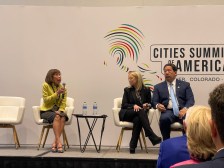San Antonio looks to eliminate bias within ‘smart city’ planning

San Antonio will aim to ensure that its “smart city” plans reflect the needs of all of its 1.5 million residents by studying biases in data collected about public health and broadband coverage through the city’s community surveys, city officials told StateScoop.
A coalition of municipal agencies, including the Office of Innovation, Metropolitan Health District, Office of Equity and CivTechSA, a public-private organization, will produce an internal report next month with recommendations for the city to eliminate biases and barriers in its annual surveys that, officials said, prevent underserved communities from giving their input on city services.
Brian Dillard, the city’s chief innovation officer, and Emily Royall, the smart city coordinator, said a series of community workshops held by the agencies last month has helped determine why some neighborhoods were underrepresented in recent data on the digital divide and the coronavirus pandemic. The upcoming report will be a “testimony” of those conversations, along with concrete recommendations, Royall said.
Though the city relies on community-generated data to prioritize many of its programs, Dillard said the community interaction that stemmed from the workshops helped city officials understand that online surveys are inaccessible to roughly 20% of San Antonio households. A frequent complaint was that the language used in the surveys is too formal or translated into European Spanish rather than local dialects, creating a barrier for some non-English speaking residents.
Officials also found that some San Antonio residents felt excluded by the surveys.
“Not only is the digital divide a barrier to participation, but some of the categories we use for race, gender and ethnicity aren’t representative of how much of our public identifies,” Royall said.
The city has been issuing community surveys to residents with online forms and in-person door-to-door campaigns for eight years, asking them to identify how city services, like waste removal, 911, libraries and parks could be improved. But only within the last two years has the city considered how the survey itself could be improved, Dillard said.
“When we came in, there was a push to do more community engagement,” he said. “What the City of San Antonio did not want to do was do this ‘independent’ smart city thing based on what other cities are doing, or what vendors think we should be doing.”
Dillard and Royall were hired in late 2018 to help jump-start San Antonio’s smart city planning and spent the first three months of their tenure learning what problems city residents wanted to tackle first by collecting community data, rather than solely relying on traditional “smart city” infrastructure like data-capturing sensors. A study on the digital divide completed last February confirmed their expectations that communities with less access to city services would show up less in the community-generated data, effectively reducing their chance to offer an opinion on how to make city services more equitable.
“One of the things we identified throughout, after the first month of a two-month survey phase, was that the way we’re collecting data really turned out to allow underrepresented communities to be lower-represented in our data, which we expected,” Dillard said.
In response, the city deployed more on-the-ground survey workers in a census-like effort to gather the opinion of people who lived in those underrepresented communities without internet access. Royall said that strategy worked, and helped the city create more accurate broadband coverage maps than what the State of Texas or federal government offered.
Meanwhile, as the coronavirus pandemic spread throughout the city, Royall and Dillard were building online, data-driven dashboards for San Antonio’s metro health agency when they were asked to take a similar approach to seeking out potential biases in public health data collection. That project will further examine how the city could tailor its communication to underserved residents, Royall said.
“Our budget, how we spend money, how we allocate our programs, how we make decisions and design policy at the city is all based on data,” she said. “So we need to make sure that we’re collecting data in ways that actually reflect the voices of our community.”






